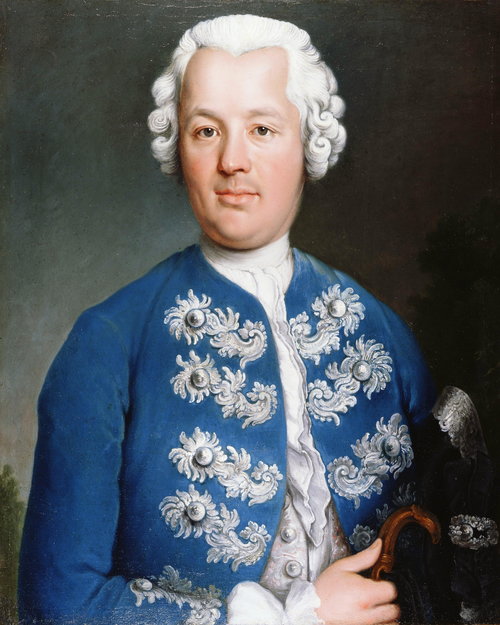An International Mystery at the Fraunces Tavern Museum
A recent email newsletter from the Fraunces Tavern Museum raised interesting questions about one of its prize artifacts, the painting shown here.
The article said:
But now there’s reason to question whether that portrait shows Fraunces at all. As the museum explains in this article, in December 2017 a German historian named Arthur Kuhle contacted the museum about a painting of an unknown nobleman at the Staatliche Kunstsammlungen in Dresden. That man’s face and wig look very much like the picture of Samuel Fraunces, and the clothing is similar.
Kuhle hypothesizes that the Dresden portrait came from the court of Frederick the Great and shows one of that king’s six most intimate friends in the 1740s. Evidently Frederick had portraits of all six of those men painted, and only four survive. Judging by other images of the two missing men, I think the most likely candidate from that group is Michael Gabriel Fredersdorf (1708-1758). He was allegedly a royal lover who rose from a soldier guarding the prince to a powerful court administrator before he married a woman, fell from favor, and died.
But of course the Dresden portrait may show someone entirely different, not even from Prussia. And the Fraunces Tavern portrait likewise. Even the resemblance could be a coincidence or the sign of an artist with a limited range. There’s much more research to do.
The idea that Samuel Fraunces was African-American is still unlikely. His nickname might have reflected his Caribbean background in some way, or perhaps his coloring was just darker than the man in this painting—whoever he was.
The article said:
Since November 17, 1913 the Sons of the Revolution in the State of New York have been proud to refer to the man in the portrait…as Samuel Fraunces, a New York City tavern keeper, an entrepreneur, an American Revolution spy, and a professional relation of George Washington. But this article is not about the man but the continued research being conducted on the painting and its sitter.This portrait comes up in discussions of Fraunces’s nickname, “Black Sam.” In the early and mid-twentieth century, many African-Americans interpreted that name to mean the tavern keeper was of African descent. That would have been remarkable, given Fraunces’s social standing in slaveholding New York, but none of his contemporaries wrote anything else to support the idea. And of course the portrait shows a pale man.
This 18th century Museum object was purchased by the Society for thirty-five dollars at auction from Merwin Sales Company in 1913. The auction catalogue lists this painting along with other items for sale, “Artist Unknown / Colonial Period / Portrait of Samuel Fraunces. / Canvas. Height 29in.: width, 23in.” Since 1913 the portrait has hung proudly in the Museum’s galleries and always interpreted as the image of Samuel Fraunces.
But now there’s reason to question whether that portrait shows Fraunces at all. As the museum explains in this article, in December 2017 a German historian named Arthur Kuhle contacted the museum about a painting of an unknown nobleman at the Staatliche Kunstsammlungen in Dresden. That man’s face and wig look very much like the picture of Samuel Fraunces, and the clothing is similar.
Kuhle hypothesizes that the Dresden portrait came from the court of Frederick the Great and shows one of that king’s six most intimate friends in the 1740s. Evidently Frederick had portraits of all six of those men painted, and only four survive. Judging by other images of the two missing men, I think the most likely candidate from that group is Michael Gabriel Fredersdorf (1708-1758). He was allegedly a royal lover who rose from a soldier guarding the prince to a powerful court administrator before he married a woman, fell from favor, and died.
But of course the Dresden portrait may show someone entirely different, not even from Prussia. And the Fraunces Tavern portrait likewise. Even the resemblance could be a coincidence or the sign of an artist with a limited range. There’s much more research to do.
The idea that Samuel Fraunces was African-American is still unlikely. His nickname might have reflected his Caribbean background in some way, or perhaps his coloring was just darker than the man in this painting—whoever he was.



